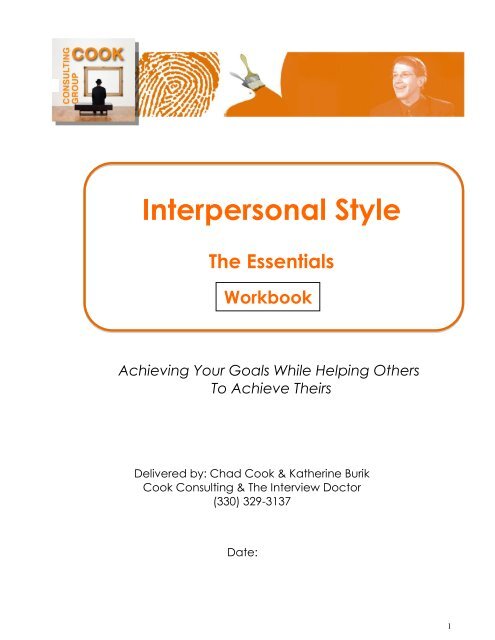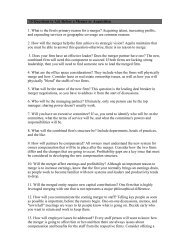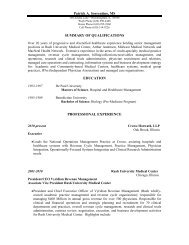Interpersonal Style - CPAReport
Interpersonal Style - CPAReport
Interpersonal Style - CPAReport
Create successful ePaper yourself
Turn your PDF publications into a flip-book with our unique Google optimized e-Paper software.
<strong>Interpersonal</strong> <strong>Style</strong>The EssentialsWorkbookAchieving Your Goals While Helping OthersTo Achieve TheirsDelivered by: Chad Cook & Katherine BurikCook Consulting & The Interview Doctor(330) 329-3137Date:1
Understanding People DifferencesNonverbal CommunicationWhen you observe another person’s style, you need to consider their nonverbal behavior.• Body language• Use of space• Voice intonationBecoming a Better ObserverMuch has been written about the meaning of nonverbal communication, yet no dictionary exists. We usually translate thesesilent messages based on instinct, experience and perhaps a little knowledge. A surprising amount of our interpersonalcommunication is nonverbal. Experts tell us that it can be as high as 83%.Understanding the importance of nonverbal communication as it relates to interpersonal style is essential if you are to put themodel to work.DominanceDominance ScaleDefinition: A measurement of a person’s inclination to be forceful, dominant, or assertive in relationships. High scores indicate atendency to direct be direct, outgoing, and vigorous in one’s actions. Low scores indicate a tendency to ask questions, processideas, and defer to others.(D) (C) (B) (A)Tendencyto yieldLOWHIGHTendencyto dominate• Leans back• Cooperative stance• Gives up space• Unassuming speech• Speaks slowly• Leans forward• Competitive stance• Acquires space• Raises voice for emphasis• Speaks rapidlyEach quartile represents 25% of the population.2013 Cook Consulting chad@cookconsulting.biz 3
Understanding People DifferencesSociabilitySociability ScaleDefinition: A measurement of a person’s inclination to show emotions and feelings in relationships. High scores indicate a prosocialand communal orientation toward others. Low scores indicate a tendency to be reserved, cautious, and formal inrelationships.(1)(2)(3) (4)SociallyReservedLOWHIGHSociallyOutgoing• Actions restrained• Actions open• Limited body motion• Animated flowing gestures• Limited facial expression• Unlimited facial expressions• Formal, ordered• Casual use of space• Little voice inflection• Many voice inflectionsEach quartile represents 25% of the population.Attributes of Successful CommunicatorsEffective communicators are versatile and adaptive. They can draw on an extensive repertoire ofbehaviors in order to meet the needs of others, but more importantly they show empathy in their dailyinteractions. They realize that the same behavior does not work equally well with everyone, and theyadapt their behavior accordingly.1. Learn about people’s needs and preferences.2. Work on the attitude and skills of empathy—people’s concerns, hopes, dreams, and motivations.3. Build a genuine rapport by adapting their style to meet the expectations of others.4. Remember that trust is reciprocal.5. Ask for feedback (informal and formal) about their effectiveness in managing relationships.6. Open up to others in a genuine way.7. Communicate with candor and sincerity.8. Act as a role model for understanding and accepting others’ styles.9. Seek first to understand before being understood.10. Show respect in daily interactions<strong>Style</strong> Patterns2013 Cook Consulting chad@cookconsulting.biz 4
<strong>Style</strong> PatternsThe ModelWhen the two dimensions are combined, they form a matrix depicting four distinct behavior patterns commonly known asinterpersonal styles.The <strong>Interpersonal</strong> <strong>Style</strong> MatrixAnalytic 4ReservedDriving 1analyticalbehaviordrivingbehaviorYieldingDominatingamiablebehaviorexpressivebehaviorAmiable 2OutgoingExpressive 3Important Things to Keep in Mind about <strong>Interpersonal</strong> <strong>Style</strong>s• Everyone has some elements of all four <strong>Interpersonal</strong> <strong>Style</strong>s.A person’s <strong>Interpersonal</strong> <strong>Style</strong> describes the most evident observable behavior patterns; theirpredominant Comfort Zone.• There is no right or wrong place to be.People of each style quadrant are simply different, not better or worse. Each style has both strengthsand challenges. By understanding <strong>Interpersonal</strong> <strong>Style</strong>, we can each leverage our style strengths andimprove on our style challenges. We can learn to be more “likeable”2013 Cook Consulting chad@cookconsulting.biz 5
<strong>Style</strong> PatternsThe 16 Quadrant MatrixSub-QuadrantsEveryone has some elements of all four <strong>Interpersonal</strong> <strong>Style</strong>s. As a result, it can behelpful to further divide each <strong>Interpersonal</strong> <strong>Style</strong> Pattern into sub-quadrants.D1C1B1A1Deliberative-analyticalAnalyzer-tacticianOrganizer-operatorDirective-driverD2C2B2A2Designer-organizerInitiator-implementerAdministrator-supervisorStrategist-producerD3C3B3A3Supporter-clarifierRelater-managerExplorer DeveloperMotivator-doerD4C4B4A4Counseling-amiableFacilitator-protectorMentor-facilitatorImaginer-expressive2013 Cook Consulting chad@cookconsulting.biz 6
Managing RelationshipsManaging RelationshipsRelationship TensionTension is a force that helps shape our behavior patterns—our interpersonal style. It helps define the behavioral map thatguides us along in the world as we adopt actions that meet our needs. This is the positive contribution of tension. But too muchtension can produce negative results in our interactions, particularly when our needs are not met.• Tension is a feeling we experience when a need is not met.• Tension is something we do to ourselves.• Tension can be managed.ComfortHighThe Comfort Zone ContinuumDefines relationship stress or tension as perceived by others in interpersonal interactions. Remain emotionally steady understress.StressLow High ComfortEmo• Rigid• Resists change• Stubborn• Impatient• Over reactive• Tense• Negotiable• Adaptable• Open-minded• Patient• Purposeful• Calm2013 Cook Consulting chad@cookconsulting.biz 7
Managing RelationshipsManaging RelationshipsApplying Structure – Orderliness ScaleDemonstrating and applying structure to relationships is a characteristic that helps shape our behavior patterns—ourinterpersonal style. It helps define the behavioral map that guides us along in the world as we adopt actions that meet ourneeds. This is the positive contribution of structure. Others respond to the structure we apply to our relationship with thembased on their need, or lack of need, for structure. They endorse or don't endorse the level of structure we apply to therelationship as indicated in their comfort ratings.• Structure is applied based on our personal need for it.• Structure can be applied based on our perceived need for others.• The level of application of structure can be managed.OrderlinessHighThe Orderliness ScaleMeasures the endorsement level of structure applied to a relationship as perceived by others in interpersonal interactions.Varies based on the perception of others.Low OrderlinessLow High High Orderliness• Low self structure• Low applied structure• Random• Appears disorganized• Tough to pin down• Appears haphazard• High self structure• High applied structure• Organized• Logical• Process oriented• Prioritizes2013 Cook Consulting chad@cookconsulting.biz 8
Basic Need: AchievementGrowth Action: ListenCharacteristics of Driving I <strong>Style</strong>s• Quick to act• Decisive• Likes challenges• Deal with difficult issues quickly• Make things happen<strong>Style</strong> PatternsSnapshotOften referred to as, driving behavior, this style combines high dominance and low sociability. They get results throughassertive and controlled behavior. Action oriented, they are competitive and resourceful. They prefer to deal with immediatelyrelevant issues and excel at defining goals along with a plan to reach them.Their behavior is perceived as direct, forceful, competitive, fast-paced and results-focused. This style prefers a challengingwork environment in which they can define the structure and orchestrate the results. They do not hesitate to make toughdecisions, even if contrary to the desires of others.Strengths• Results Oriented• Forceful• Like ch allengesChallenges• Poor listener• Insensitive• UnyieldingStrategies for Working with this <strong>Style</strong>Plan actions that are . . .• Clear, specific, brief• Businesslike, results oriented• Specific when asking questions• Organized with alternatives, options and choices• Presented with facts about probabilities• With support for their conclusions and actions• Ready to stress resultsAvoid actions that are . . .• Vague, time wasting• Personal, informal, casual• Pretentious, irrelevant• Conclusive or arbitrary• Careless with facts and forecasts• Direct or forceful• Personalizing the decision2013 Cook Consulting chad@cookconsulting.biz 9
Basic Need: SecurityGrowth Action: Initiate<strong>Style</strong> PatternsCharacteristics of Amiable II <strong>Style</strong>s• Supportive• Good listeners• Ask questions• Share personal feelings and emotions• Team playersSnapshotOften referred to as amiable behavior, this style combines low dominance and high sociability. They readily show their feelingsand are not particularly aggressive. Relationship-oriented, these styles tend to be supportive and seek cooperation throughteamwork. As team leaders, they recognize and encourage active participation. Relationship building is a major strength.Their behavior is perceived as friendly, unassuming, and supportive. They are seen, as warm individuals who tend to give andreceive trust easily. They place a high value on maintaining positive relationships in a harmonious manner.Strengths• Good listener• Sensitive to others• Team playerChallenges• Too trusting• Not able to confront• Too easy-goingStrategies for Working with this <strong>Style</strong>Plan actions that are . . .• Candid, open, patient• Showing personal interest• Patient, responsive to their ideas• Supporting teamwork and harmony• Having a well defined idea but negotiable• Supporting win/win relationships• Ready to provide “fail-safe” planAvoid actions that are . . .• Loosely organized, unstructured• Informal, too casual• Too general about your plan• Vague about what is expected of each party• Leaving loose ends; poor follow-through• Too reliant of others• Unrealistic or aggressive about deadlines2013 Cook Consulting chad@cookconsulting.biz 11
Basic Need: RecognitionGrowth Action: Check<strong>Style</strong> PatternsCharacteristics of Expressive III <strong>Style</strong>s• Quick paced• Stimulating• Prefer involvement• Take risks• PersuasiveSnapshotOften referred to as expressive behavior, this style combines high dominance with high sociability. They express strong feelingsabout their goals. They often rely on their intuition to guide their actions, engaging and inspiring others to follow along. With afuture orientation, they are able to show others the big picture. They are persuasive competitors.Typically vigorous, outspoken, and resourceful, Pattern III styles emphasize interaction and involvement with others whenworking toward a goal. Leadership is premised on influence and persuasion rather than control.Strengths• Persuasive• Instinctive• EnthusiasticChallenges• Impulsive• Too general• CarelessStrategies for Working with this <strong>Style</strong>Plan actions that are . . .• Supporting their ideas and concepts• Stimulating, thought provoking• Discussing other’s successes• Encouraging commitment to a plan• Seeking their opinions and ideas about people• Contributing ideas to a plan• Offering incentives to take risksAvoid actions that are . . .• Arbitrary of directive• Unyielding, too structured• Too rigid about the plan• Wasting time on formalities and protocol• Emphasizing concepts too much• Direct or forceful• Sticking too tightly to a formal agenda2013 Cook Consulting chad@cookconsulting.biz 12
Basic Need: To be rightGrowth Action: Declare<strong>Style</strong> PatternsCharacteristics of Analytic IV <strong>Style</strong>s• Seeks facts and data• Time disciplined• Problem solving skills• Conservative• PracticalSnapshotOften referred to as analytical behavior, this style Combining low sociability with low dominance. They are planners andorganizers. Thinking oriented, they prefer to work alone or in a small group. Their decisions are based on critical thinking and athorough examination of the facts. They are risk averse.Thorough, logical and cautious are good descriptors of this style. Pattern IV styles are focused on quality. Leadership ispremised on competence and know how rather than forcefulness and persuasion. They are characterized as businesslike andobjective in dealing with others.Strengths• Thorough• Crit ical thinker• Detail orientedChallenges• Aloof• Poor improvise r• Slow decision - makerStrategies for Working with this <strong>Style</strong>Plan actions that are . . .• Well prepared, having an agenda• Direct, orderly, patient• Oriented toward specifics• Doing what you say you will do• Prepared with a schedule including action steps• Amenable toward verifying the plan• Having timeline with follow-up planAvoid actions that are . . .• Loosely organized, unstructured• Informal, casual• Too general, informal plan• Vague about what is expected of each party• Leaving loose ends; no follow-through plan• Too reliant on assumptions• Unrealistic plan and deadline2013 Cook Consulting chad@cookconsulting.biz 13
Managing RelationshipsSummary of <strong>Style</strong> Elements<strong>Style</strong> Pattern I Pattern II Pattern III Pattern IVBasic Orientation Action Relationships Intuition ThinkingUse of Time Immediate Present Future HistoricalRelating to Others Task first Key priority Likes an audience Cautious actionsTasks Primary importance Relationships mostimportantDecision-making Quick, goal oriented Slow, peopleorientedMust be excitingFast, intuitionorientedProcess takesprioritySlow, processorientedAction planningquestionsMaximum Efforttoward othersWhat? Why? Who? How?Control Relationships Involvement ProcessFirst Priority Achievement Teamwork Leadership PlanningSource of Tension Inaction Conflict Isolation InvolvementMajor Strength Decisive Supportive Enthusiastic ThoroughMajor WeaknessTends to beInsensitive to other’sfeelingsTends to avoidsconfrontationTends to actimpulsivelyMay be reluctant toimproviseFallback Behavior Autocratic Acquiesce Attack AvoidTeamworkEvery team has a common goal or mission along with structures and processes that make it function. The success of a team,however, depends on mutual cooperation and support. As you review the chart above, it should be apparent that the strength ofone style may be the weakness of another. An awareness of each other’s styles helps you to appreciate the potential of eachindividual and how he or she can not only contribute to the success of the team, but also make work much more fun!2013 Cook Consulting chad@cookconsulting.biz 14
Managing Relationships<strong>Style</strong> StretchingAn awareness of your style along with skill atmeeting the style needs of others will help you toimprove your overall effectiveness.If you are perceived as . . . Take actions to . . .Socially Reserved • Say what you feel.• Make personal remarks.• Devote more time to relationships.• Engage in small talk.Socially Outgoing • Talk less.• Restrain enthusiasm/feelings.• Make decisions based on solid evidence.• Acknowledge opinions of others.Less Dominant • Volunteer opinions and information.• Make points clearly.• Be willing to disagree.• Initiate conversations.More Dominant • Listen without interrupting.• Talk less and ask for others’ opinions more.• Adapt to time needs of others.• Allow others to take the lead.2013 Cook Consulting chad@cookconsulting.biz 15
Managing RelationshipsThe Versatile Relationship Manager<strong>Interpersonal</strong> <strong>Style</strong> can be an important tool to improve your relationships. It can help you to create more productiverelationships. You can learn to meet the leadership expectations of others more often by temporarily abandoning your stylepreferences, Comfort Zone, and moving into the other person’s arena of expectations.<strong>Interpersonal</strong> <strong>Style</strong> is an empathy tool. You can use it to better understand yourself and others, and to improve the quality andeffectiveness of your relationships. When a person exhibits a behavior, <strong>Interpersonal</strong> <strong>Style</strong>s helps to avoid “making stuff up”since it is based on what we observe rather than our judgment.Key Actions<strong>Style</strong> Question? Support Use ofTimeDriving 1What?Help Them DecideConclusions and actions Efficiently Options with probabilitiesAmiable 2 Why? Teamwork and harmony Agreeably Assurances and supportExpressive 3 Who? Ideas and concepts Flexibly Ideas and incentivesAnalytic 4 How? Principles and thinking Accurately Evidence with service2013 Cook Consulting chad@cookconsulting.biz 16
Exercise: Personal Action Plan<strong>Style</strong> Identification Checklist(Make copies of this page)Person observed:DC B AFor each of the 18 items below,circle the number or letter that bestdescribes the person.Count the number of circles in eachcolumn of letters and numbers. Putthe totals on the total line.Put an “X” in the square of the gridthat represents the letter and numberwith the highest total count.1234Dominanceaccepting ................................... confrontingD C B Areticent ....................................... outspokenD C B Ago along ..................................... take chargeD C B Acompliant ................................... dominantD C B Anon-assertive ............................. assertiveD C B Adeliberative ................................ decisiveD C B Aasks questions ........................... states ideasD C B Aslow-paced ................................. fast-pacedD C B Acooperative ................................ competitiveD C B ASociabilityrigid ............................................ flexible1 2 3 4calm ........................................... excitable1 2 3 4serious ....................................... fun-loving1 2 3 4cold ............................................ warm1 2 3 4formal ......................................... informal1 2 3 4reserved ..................................... sociable1 2 3 4guarded ...................................... open1 2 3 4little movement........................... frequent movement1 2 3 4controlled ................................... animated1 2 3 4TotalD C B ATotal1 2 3 42013 Cook Consulting chad@cookconsulting.biz 17
Exercise: Personal Action PlanD C B AExacting, orderly, preciseRelies on facts and logic. Exploresall avenues before making adecision. Preferred leadershipstyle based on competence ratherthan force. Completes projects ina focused manner. In stressfulsituations may avoid peopleinvolvement.Reserved, conservative, orderlyPrefers a situation that calls forindependent analysis or expertise.Tends to lead by example. Enjoysa leadership role in which knowhowand technical expertise areimportant. Will strive for a logicalsolution.Controlling, task-oriented,formalStrives for accuracy anddependability in performance. Asituation that depends on technicalexpertise satisfies control needs.Leads by example rather thanfeelings. May down play theimportance of relationships.Takes charge, competitive, taskorientedPrefers to deal with immediatelyrelevant issues. Defines goals witha means of reaching them. Valuesand rewards loyalty among teammembers. Achievement oriented.Under stress may becomeunyielding.1Moderate, restrained, methodicalWorks best alone and on clearlydefined tasks. Good listener.Tends to influence through reasonrather than power. May bereluctant to direct orders. May relyon expertise more than assertion tosucceed.Task-oriented, cooperative,practicalTends to depend on themselves toget the job done, but recognizesthe need for cooperation andsupport. Will reach out to peers.Usually responds to feedback well.Resolves conflict by combiningreasoning with diplomacy.Purposeful, business-like,moderateWorks best in a well-definedsituation in which they determinethe course to follow. Likes to beviewed as the authority figure, butprefers “win/win.” May be seen assingle-minded. Tends to rely onpower and position.Straightforward, competitive,aggressiveComfortable in directing others.Can influence by their personalforce. Often perceived as singleminded and too assertive. When asituation is consistent with theirgoals they will support a teameffort. Praise is a motivator.2Unpretentious, friendly,consistent.Tends to be an effective listenerand usually gains endorsementthrough good diplomatic skills.Prefers to motivate by examplerather than authority. Tends to likewell defined tasks. May beuncomfortable directing others.Efficient, cooperative, realisticTends to generate confidence andtrust through persuasion ratherthan force. Can be direct andassertive to maintain support.Generally supportive andcooperative. Most effective insituations needing a moderate,conservative stance.Sociable, moderate, tactfulUsually concerned with theimportance of relationships and arewilling to listen to another person’spoint of view. Prone to influencethrough persuasion, but tries tobalance the need to achieve theneed for acceptance. May rely tooheavily on persuasion to results.Outgoing, outspoken,stimulatingCompetition and involvement arekey. They are persuasivecompetitors. Will put forth a strongeffort to achieve recognition andreward. Won’t hesitate to expressopinions strongly. May be overlyaggressive in stressful situations.3Supportive, informal,cooperativeTends to have strong social drives.May depend on feelings more thanfact or necessity when makingdecisions. Prefers to deal withpresent day issues. May be tootrusting and accepting. May not beable to confront tough issues.Supportive, responsive,agreeableEspecially responsive to others’point of view. Generally thought ofas a team player. May go with theconsensus rather than take anindependent stand. Relaxed withothers and listens well. Respondswell to constructive criticism.Enthusiastic, visionary,supportiveSensitive to the importance ofrelationships. Can deal with avariety of views tactfully,particularly in a group setting. Ateam player. Skillful at gettingconsensus decisions. Respondswell to input from others.Spontaneous, enthusiastic,futuristicTends to be strongly extroverted.Will emphasize interaction andinvolvement when working towarda goal. Often focuses on highvisibility task directed at a futuregoal. Can elicit a strong response,particularly in stressful situations.42013 Cook Consulting chad@cookconsulting.biz 18
Personal Action Plan(Make copies of this page)<strong>Style</strong> Stretch StrategiesYou can modify your style to meet theexpectations of similar and different styles.Use the <strong>Style</strong> Identification Checklist todetermine the style of the person with whomyou would like to improve your relationship.Place an “X” on the grid to mark his/her style.Determine your style stretch objective byPlacing an “M” next to the position that youwould like to be on the matrix in order to bemost effective with the other person.Then respond to the following:1234D C B APerson’s Name:I will modify my tendency to be reserved/open. Place an “X” in one of the following:□ increase □ decrease □ no changeI will modify my tendency to dominate/yield. Place an “X” in one of the following:□ increase □ decrease □ no changeSelf Management Strategies:I plan to meet my relationship objectives with this person by stretching my style preferences as follows:Support:Use my time:Encourage decisions:Versatility Performance Goal2013 Cook Consulting chad@cookconsulting.biz 19
Useful Tips• Ask yourself whether you adjust your interpersonal style to fit the situation, or whether you expect the situation tofit your style.• Gather feedback from trusted colleagues when your style is not working for you.• Remember the law of the harvest; in a relationship you will reap what you sow.• View sharing information as an opportunity rather than a burden.• First seek to understand, then to be understood.• Project confidence when you communicate.• Avoid mixed signals; people tend to interpret the worst case possibility.• Determine two or three behaviors that if adopted would result in improved performance.• Thank people for constructive feedback and recognize how difficult it may be to provide.• Be part of the solution, not part of the problem.• Identify whether your organization has a preferred interpersonal style, and how that affects your own performance.• Determine whether people expect you to interact in a certain way and how that may affect your relationshipproductivity.• Sometimes you have to apply more of your preferences to help others achieve what they want to achieve. Betransparent about it and why you are doing it to create a win/win/win for everyone involved.2013 Cook Consulting chad@cookconsulting.biz 20
16 Quadrant Matrix – Other LinksMBTI, Disc, Insights, Wilson Learning, HRDQ <strong>Style</strong>Pattern IVPattern ICool BlueDiSC “C”Fiery RedDiSC “D”Earth GreenDiSC “S”Sunshine YellowDiSC “I”Pattern IIPattern III21






